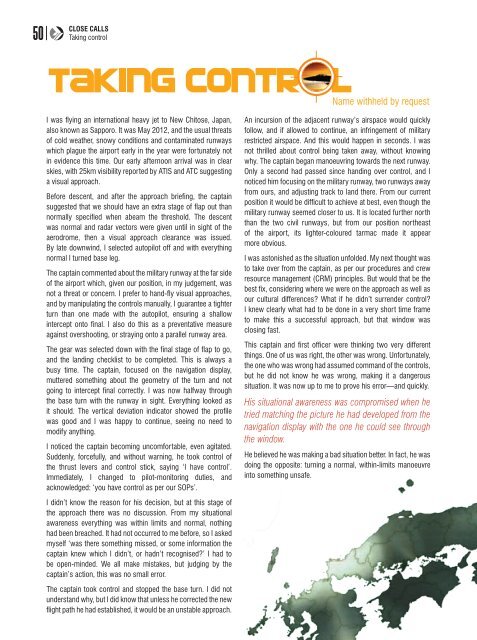jul-aug2012
Create successful ePaper yourself
Turn your PDF publications into a flip-book with our unique Google optimized e-Paper software.
50<br />
CLOSE CALLS<br />
Taking control<br />
Name withheld by request<br />
I was flying an international heavy jet to New Chitose, Japan,<br />
also known as Sapporo. It was May 2012, and the usual threats<br />
of cold weather, snowy conditions and contaminated runways<br />
which plague the airport early in the year were fortunately not<br />
in evidence this time. Our early afternoon arrival was in clear<br />
skies, with 25km visibility reported by ATIS and ATC suggesting<br />
a visual approach.<br />
Before descent, and after the approach briefing, the captain<br />
suggested that we should have an extra stage of flap out than<br />
normally specified when abeam the threshold. The descent<br />
was normal and radar vectors were given until in sight of the<br />
aerodrome, then a visual approach clearance was issued.<br />
By late downwind, I selected autopilot off and with everything<br />
normal I turned base leg.<br />
The captain commented about the military runway at the far side<br />
of the airport which, given our position, in my judgement, was<br />
not a threat or concern. I prefer to hand-fly visual approaches,<br />
and by manipulating the controls manually, I guarantee a tighter<br />
turn than one made with the autopilot, ensuring a shallow<br />
intercept onto final. I also do this as a preventative measure<br />
against overshooting, or straying onto a parallel runway area.<br />
The gear was selected down with the final stage of flap to go,<br />
and the landing checklist to be completed. This is always a<br />
busy time. The captain, focused on the navigation display,<br />
muttered something about the geometry of the turn and not<br />
going to intercept final correctly. I was now halfway through<br />
the base turn with the runway in sight. Everything looked as<br />
it should. The vertical deviation indicator showed the profile<br />
was good and I was happy to continue, seeing no need to<br />
modify anything.<br />
I noticed the captain becoming uncomfortable, even agitated.<br />
Suddenly, forcefully, and without warning, he took control of<br />
the thrust levers and control stick, saying ‘I have control’.<br />
Immediately, I changed to pilot-monitoring duties, and<br />
acknowledged: ‘you have control as per our SOPs’.<br />
I didn’t know the reason for his decision, but at this stage of<br />
the approach there was no discussion. From my situational<br />
awareness everything was within limits and normal, nothing<br />
had been breached. It had not occurred to me before, so I asked<br />
myself ‘was there something missed, or some information the<br />
captain knew which I didn’t, or hadn’t recognised?’ I had to<br />
be open-minded. We all make mistakes, but judging by the<br />
captain’s action, this was no small error.<br />
The captain took control and stopped the base turn. I did not<br />
understand why, but I did know that unless he corrected the new<br />
flight path he had established, it would be an unstable approach.<br />
An incursion of the adjacent runway’s airspace would quickly<br />
follow, and if allowed to continue, an infringement of military<br />
restricted airspace. And this would happen in seconds. I was<br />
not thrilled about control being taken away, without knowing<br />
why. The captain began manoeuvring towards the next runway.<br />
Only a second had passed since handing over control, and I<br />
noticed him focusing on the military runway, two runways away<br />
from ours, and adjusting track to land there. From our current<br />
position it would be difficult to achieve at best, even though the<br />
military runway seemed closer to us. It is located further north<br />
than the two civil runways, but from our position northeast<br />
of the airport, its lighter-coloured tarmac made it appear<br />
more obvious.<br />
I was astonished as the situation unfolded. My next thought was<br />
to take over from the captain, as per our procedures and crew<br />
resource management (CRM) principles. But would that be the<br />
best fix, considering where we were on the approach as well as<br />
our cultural differences? What if he didn’t surrender control?<br />
I knew clearly what had to be done in a very short time frame<br />
to make this a successful approach, but that window was<br />
closing fast.<br />
This captain and first officer were thinking two very different<br />
things. One of us was right, the other was wrong. Unfortunately,<br />
the one who was wrong had assumed command of the controls,<br />
but he did not know he was wrong, making it a dangerous<br />
situation. It was now up to me to prove his error—and quickly.<br />
His situational awareness was compromised when he<br />
tried matching the picture he had developed from the<br />
navigation display with the one he could see through<br />
the window.<br />
He believed he was making a bad situation better. In fact, he was<br />
doing the opposite: turning a normal, within-limits manoeuvre<br />
into something unsafe.

















